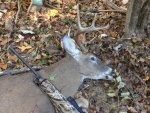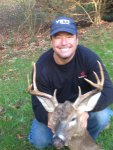Bioguy
Senior Member
Interesting points, but i have to ask if you actually read what I wrote and actually watched the video you posted?
1. I dont believe the full moon influences the rut either, it just happens to fall around the same time every year. Just a coincidence.
2. The majority of what I wrote was to help understand how WEATHER influences movement. That's useful information on any day that can be used to determine whether or not to even bother going to the stand. I also stated that if weather conditions were not right, weather trumps moon phase pretty much every time.
3. This is probably the reason there have not been solidly conclusive studies on the moon phase and deer movement because there is no where you can conduct that study without weather influencing the results. So we will never really know.
4. His studies confirmed that they moved more in the middle of the day during the full moon. And you are right, deer are crepuscular, meaning they move around twilight and dawn every day. Never said that you dont see deer in the morning of a full moon. There have actually been many time ive seen as many as 15-20. Ive seen very nice bucks in the morning as well. Generally they have been right at daylight or before, but ive seen the occasional nice shooter buck between 7:30 and 8:30. But I have seen the most shooters bucks in the mid day time frame. There is no guaranteed method. I saw a crap load of movement yesterday between 12 and 3 yesterday. Including a BIG BIG buck. The video also said that the moon did not seem to influence when they move, but it did effect the intensity of movement. Well the full moon increases intensity in the middle of the day. Most hunters think deer lay down and sleep all day until evening. This is not true. Deer will move several times during the day, they just don't move in areas where most hunters WANT them to be. You can't hunt deer where you want to see them, you have to hunt where they are. They are not moving in and out of feeding areas, so that stand between the food plot or on the food plot is likely not going to be successful at seeing mature deer in the morning. Every once in a while you may luck out and assume that what I wrote is crap. All I am trying to say is that if you want to have a better chance of shooting a mature deer during the full moon, you need to hunt mid day. I always hunt the morning of a full moon. You never know. And the earlier you get in the stand the better. When conditions favor morning and evening movement, which is every other phase of the moon you should absolutely hunt near food sources morning and afternoon and skip the second shift (unless it is the rut as deer move constantly during the rut). I wrote this to help other frustrated hunters who hate the full moon understand why it seems that they were generally unsuccessful, and show them what they could do to increase their odds. At the end of the day its all about increasing odds. There is no fool proof method that guarantees success. Sometimes you strike out. But I promise if you learn to understand how different factors affect deer movement, and apply that to when and more importantly where you hunt, you will see more QUALITY bucks. And Im not talking about 8 and 10 points that are actually only a 1.5 to 2.5 years old, I have let more of those walk than I can count. Im talking about that mature 3.5+ year old bucks that are worth harvesting that you've seen on your trail cam but never see when your hunting. Hunt him where he is, not where you want him to be.
Not only have I watched the video I posted, I have talked with Marcus about the subject. As I said, his study had some good insights and observations, but the results are not conclusive. It is not realistic to generalize deer movement for the entire southeast from 16 adult does on 1 study area. Marcus has since collected data sets from GPS collared deer across the US to check for moon phase relationships and that analysis is still underway.
You asked if anyone else had input to provide ("P.S. Please feel free to add your experiences and thought to this thread."), and that's what I did. Agree with it or disagree with it, I provided my input. Just here to contribute, not to argue.









 if it not working. Try just plain ol fashioned waiting.
if it not working. Try just plain ol fashioned waiting.